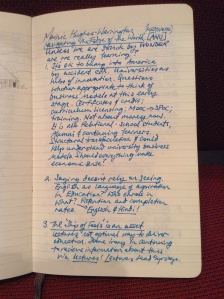Tagged: education
Academic libraries, design and creative futures
This is a presentation (slides and speaker’s notes) from a presentation that I gave last week. It was a public talk at a UTS Shapeshifters event on Creative Futures. I was humbled to be on stage with Paola Antonelli from MoMA and Professor Anthony Burke and Hael Kobyashi from UTS. Read more here:
http://newsroom.uts.edu.au/events/2013/12/shapeshifters-creative-futures
I should explain more about the 3rd slide. The things listed on that slide are often forgotten or discounted in the blind pursuit of efficiency or traditional KPIs. For libraries, these things (i.e. delight, surprise, engagement, serendipity and curiosity) are at least as important and should not be forgotten, dismissed or left until later.
The video of this talk is also now available:
Highlights from Educause 2013 #2: Mimi Ito, UC Irvine
Session: Open Networks for Social and Connected Learning
Professor Mimi Ito from UC Irvine is a Cultural Anthropologist. This was a great follow-up to Ken Robinson’s keynote.
She talked about adapting educational technology in the 21st century to platforms that can connect classrooms to a wider world of learning. For middle school kids those technologies centre around games like Minecraft and media sources like YouTube.
Education lags behind changes outside the classroom. It needs to move towards open networks that: increase the amount of information that is available; are production oriented; solve problems; include civic engagement; and are inquiry based. We are not there yet.
To tap the potential we need to forge stronger connections between classrooms and the world at large. Education needs to be seamless with life itself. Technology can be a powerful ally for this agenda.
Younger people are more avid readers – in all forms. And they average 7.5 hrs per day in media consumption (it is saturated).
Gaming is the entertainment media of our time – at all levels of society.
Abundance (of options, availability, continual connection, etc.), however, can also be too much of a good thing.
An example from her research. She worked with teams of ethnographers from 2005-08 and found:
- There is a generation gap in the perceived value of online activity – younger people see it as a life line and older people see it as a waste of time (even though they use it themselves)
- What do they do & learn? Heaps! Baseline technical literacy and to be a social being. Uploading photos, managing web pages, managing profiles, interacting, judging, etc. Some online tools really allow people to do amazing things, such as uploading to YouTube channels for civic causes. Some users are really out there, but they are a minority. At the other end of the spectrum there are the bullies. She quoted GIbson: the future is already here, just not evenly distributed.
She then went on to distinguish between Friendship-driven & Interest-driven participation. This started with MySpace and Instant Messaging and is now based around Facebook and Texting (or other fast ephemeral services like Snapchat and Kik). Dorks and geeks can connect with others who have shared interests and share knowledge and expertise – so that is very different to a friendship group. She used the example of Facebook being used to connect with those you went to school with and Tumblr (or Instagram) being used for those you wish you went to school with. So FB is more about friendship (with kids seeing adults there as just creepy) and Tumblr (& the like) is more about interests. It is now easy to find and connect to an online community that is very different to the one in which you live: communities of producers with like interests. It allows and facilitates the development of potential for those resourceful enough to take/absorb/use from their peers and interest groups and then apply it in an academic community. She warned though that only a few do this.
Mimi said the academic bubble now has to reach out and facilitate those connections. To overcome the cultural gaps they face young people still need and look for adult support and guidance.
She warned that some tools can also become “weapons of mass distraction”. Attention cannot be controlled the ways we used to. We need to more creatively deal with a culture or environment of media abundance. And we don’t want to go back to an environment of scarcity.
Quoting Howard Rheingold in NetSmart she says we need strategies to cope with abundance and distractions such as: crap detection; attention management; collaboration; participation; net know-how; etc.
Referring to Open Education Resources (and MOOCs?) she said that the build-it-and-they-will-come attitude tends to re-advantage those already advantaged and only serves to widen the gap. Access is not enough.
Some guiding principles:
- leverage local relationships – peer cultures; the warm body effect is important; community based learning labs in libraries (e.g. MOOCs with local guides)
- everyone can be a teacher – (not just the traditional experts) so peer-to-peer university; everybody can help (e.g. PHONAR); use aggregators; Jim Groom’s and DS106 – digital storytelling – it lets the internet do it
- meet learners where they are – in interests; peer cultures (e.g. the Walking Dead MOOC)
- recognise learning in the wild – credentialing such as coders and gamers being recognised in LinkedIn; open badging infrastructure; learning to be more visible and under learner control
She used a three-circle diagram to show that Connected Learning happens at the intersection of three communities: Interests; peer culture; and the academy. She described communities on Google+ as connected learning.
BUT: beware of putting a pop-culture veneer on something that not so pleasant, which she described as “chocolate coating broccoli”. Actually, I don’t mind broccoli; I am sure she meant to say cauliflower.
Finishing up, she reminded us that the major challenge in all of this was in getting faculty/teachers/academics on board, not so much the students.



